|
Changes in American Megachurches:
Tracing Eight Years of Growth and Innovation
in the Nation's Largest-attendance Congregations
by Scott Thumma and Warren Bird
Note: Due to the size of this paper, you may wish to
download a copy in .pdf* for easier reading and printing.
*Note: You must have the free Adobe reader
installed on your computer to read this file.
Summary:
Megachurches – Protestant congregations that draw 2,000 or more adults and children in a typical weekend (attendance not membership) – show considerable consistency over the past eight years.
They continue to:
• Grow in size,
• Lead the way as America's most multi-ethnic class of church,
• Show a strong bias toward contemporary worship, and
• Remain minimally involved in politics.
However, they also are institutions in transition. They are now:
• Offering more worship services and expanding to multiple-locations,
• Shifting to playing a greater role in community service,
• Decreasing their use of radio and television, and
• Putting greater emphasis on the role of small groups.
These are some of the most salient findings of a national study of America's roughly 1,200 megachurches with approximately one third returning a usable response to an eight-page, 150-question survey that was fielded between February and August, 2008, with comparison given to similar (but non-longitudinal) national studies in 2000 and 2005.
_______________________________________
The Report
Three years isn’t much time in the religious world. For the most part religious institutions change slowly, so major alterations are not the norm in such a short time period. As such, this report is not so much an overview of megachurches (for that see the 2005 report at the Hartford Institute for Religion Research website, or the 2007 book Beyond Megachurch Myths by Thumma and Travis, www.megachurchmyths.com), but rather focuses more on the developing patterns observed across the 3 national surveys done in 2000, 2005 and 2008 in a partnership between the Hartford Institute for Religion Research, Hartford Seminary, www.hartfordinstitute.org, and Leadership Network, www.leadnet.org. Nevertheless, megachurches are highly adaptable and continually innovating their programs and approach to worship and congregational organization as they respond to an ever changing social context.
Thus, even in the relatively short span of 8 years since our first national study, discernible patterns are developing.
This present survey, completed in August 2008, repeated many of the questions asked in the previous research but it also contained new sections on political involvement, youth ministry, and details about clergy activities – topics which will be reported in this and future reports. Much of this research also parallels the national Faith Communities Today 2008 study, http://fact.hartsem.edu, drawn from many different religious traditions and different sized congregations, which will be released in the winter of 2008, and also an in-depth study of 25,000 attenders across 12 megachurches, to be released in February 2009.
Areas of Continuity
Before addressing the changes, a few words about what hasn’t changed much. Overall, the most distinctive characteristics of megachurches have not diminished, and if anything these traits have intensified.
• Location. Regionally, megachurches have maintained about the same distribution over the past 8 years. Likewise, they have roughly the same denominational distribution as 2005. The profile of people going to megachurches is nearly identical in each of our 3 studies. And many of these churches continue to be quite multiracial. They are also increasingly located in newer suburban areas.

• Contemporary worship style. Not surprisingly, contemporary worship (indicated by electric guitars, keyboards, drums and visual projection equipment) remains the overwhelming norm for worship. In the 2008 study 78% of megachurches thought the term “contemporary” described their worship quite or very well, with only 2% saying this didn’t describe their worship at all.

Additionally, they overall describe their worship first as joyful. Among 7 choices offered, the most-selected 2 characteristics intensified in just 3 years ("joyful" and "God's presence"), while the next 2 remained roughly the same.

• Outreach and programming. These churches continue to be highly evangelistic and invitational, with their attenders highly engaged in recruiting others to the church. Megachurches still offer numerous programs and opportunities both to be ministered to and to engage in ministry activities toward others.
They continue to define themselves as having a clear mission and purpose, holding strong beliefs and values and being spiritually vital and alive. Additionally they describe themselves as embracing innovation, willing to meet new challenges, welcoming change and ready to try new things.

• Finances. Megachurches also continue to garner significant annual incomes. In 2008, the average megachurch income was 6.5 million dollars. This represents nearly a half million increase over the average in 2005. The 2008 figure likewise marks a growth in revenue over the 4.8 million dollar income from the 2000 study, even after being adjusted to 1999 dollars. However, the current income figure actually represents a slight decline of nearly $100,000 when compared to the 2005 study figure after correcting for inflation.

Given this essentially flat financial picture over the past three years, it is somewhat surprising that the megachurch respondents for the most part indicate that they are better off now financially than they were 5 years ago. Perhaps a more accurate read of the current economic conditions can be found in a comparison of the 2008 financial health assessment with that from the 2000 and 2005 study.

For the first time, the 2008 study inquired how the megachurches spend their money, based on broad categories. While there was considerable variation among the churches reporting, generally about 50% of income went to salaries, a quarter to buildings and a quarter to missions and programs, as the graphic shows.
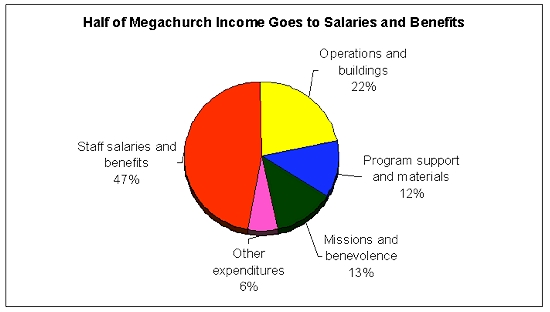
• Growth. Finally, megachurches also continue to increase in the number of people they draw. Their average rate of growth for 5 years is around 50% increase in attendance, with only slightly more than 10% of the churches showing stagnation or decline.
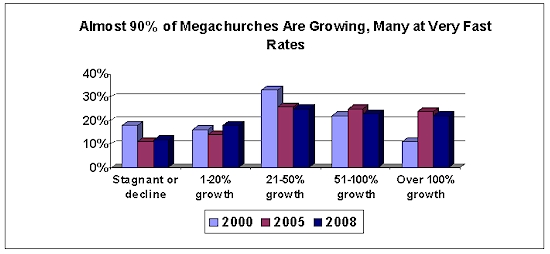
Areas of Change
While much about a typical megachurch has remained the same or intensified, there are other areas that have shown considerable shifting or realignment, even within a short 8-year period.
North Coast Church, Vista, CA (Larry Osborne, www.northcoastchurch.com) moved in 1991 to a location that has 560 seats. At the time they were drawing 800 in worship over 2 services. Today the church's largest venue is still that 560-seat auditorium, but worship attendance is now 7,300 (August 2008). It can reach so many people by sponsoring over 20 weekend services across multiple venues on 4 different campuses. Likewise the largest capacity facility at Living Hope Church, Vancouver, WA (John Bishop, www.livinghopechurch.com) has only 600 seats, yet attendance is over 5,000 due to multiple services and multiple campuses. |
• Growth without more seats. It is clear that for most megachurches attendance size is increasing, but at the same time, the size of the main sanctuary, judged by seating capacity, is remaining constant. Thus a number of strategies and organizational innovations are evident in the study that reflect new ways to continue to grow these congregations.

• Spilling over. To create the larger attendance figures, megachurches have turned to an increased use of additional gathering spaces (overflow rooms and multiple venues). Likewise, they are offering larger numbers of services over the weekend. Additionally, 35% of the megachurches say they hold simultaneous venue worship of different styles on their main campus. In addition they are holding more weekend services than they did in 2005.

• More campuses. Megachurches are also turning to the creation of off-campus satellites or multiple sites to hold additional worship services under the umbrella of a single identity, unified budget, and solo senior leader. This multi-site phenomenon first came to the attention of journalists a few years ago with the publication of The Multi-Site Church Revolution: Being One Church in Many Locations by Geoff Surratt, Greg Ligon, and Warren Bird (Zondervan, 2006). It is clear that this strategy has helped megachurches create larger congregations as well as avoid prolonged zoning battles with local government agencies.
On average, those churches surveyed in our recent study had 2 satellite locations and offered 4 services at these each weekend. At the extreme, 5% of megachurches had 6 or more locations and offered between 12 and 24 services each weekend. There is no doubt that this phenomenon is an increasing reality judging by the percentage of megachurches that said they began a satellite in each of the past 5 year time periods.
The following are among the churches that have six or more U.S. campuses: New Life Community Church, Chicago, IL (Mark Jobe, www.newlifechicago.org); Christ the King Community Church, Mt. Vernon, WA (Dave Browning, www.ctkonline.com); Seacoast Church, Mt. Pleasant, SC (Greg Surratt, www.seacoastchurch.org); LifeChurch.tv, Edmond, OK (Craig Groeschel, www.lifechurch.tv).
|
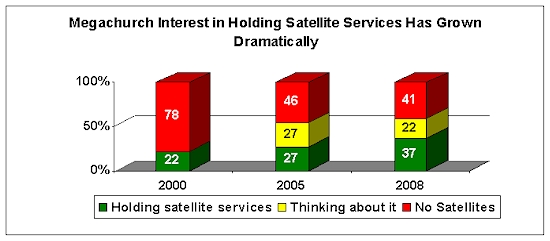
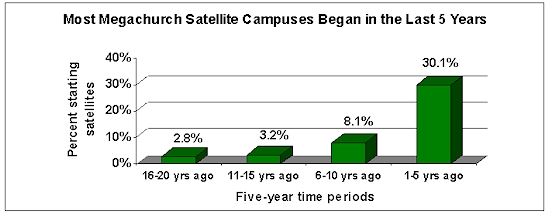
The following churches are examples of having both launched multiple campuses and have also planted several new churches: Bethlehem Baptist Church, Minneapolis, MN (John Piper, www.hopeingod.org); New Direction Christian Church, Memphis, TN (Stacey Spencer, www.n2newdirection.org); Eastern Star Church, Indianapolis, IN (Jeffery Johnson, www.easternstarchurch.org); and West Ridge Church, Dallas, GA (Brian Bloye, www.westridge.com). |
• Church Planting. One might assume that this effort to create multiple worship locations under the rubric of a single church’s identity would detract from the effort to plant new independent churches. However, such is not the case; the number of megachurches who are planting new churches is also rising according to our studies. Megachurches planting or helping to plant other congregations rose from 68% in 2000 to 70% in 2005 to 77% in 2008.
Interestingly, those churches with satellite campuses were even more likely to have planted a church; only 16% never did, compared to 26% of those without satellites who never planted another church.

• Education and interns. Another area where some shifting of emphasis within megachurches can be seen is around the effort to train other religious leaders. In 2000 42% of churches surveyed said they operated a Christian elementary or secondary school, whereas in 2008 only 25% were. Likewise 30% were maintaining a Bible school or institute in 2000 but in 2008 only 20% said they were.
On the other hand, 7% more megachurches (47% in 2000 to 54% in 2008) were sponsoring Pastors or ministerial conferences. Additionally 69% have internship/residency programs to train potential staff and ministerial candidates. So it seems as if megachurches are shifting from formal pastoral schools or institutes toward informal on-the-job internship programs for clergy training.
Elmbrook Church, Brookfield, WI (Mel Lawrenz, www.elmbrook.org), has used an interns and residents program for 30 years, with 1/3 of the current pastoral staff coming through it, including the current senior pastor. Other churches heavily using interns include Wooddale Church, Eden Prairie, MN (Leith Anderson, www.wooddale.org) and Chase Oaks Church, a Fellowship Bible Church, Richardson, TX (Jeff Jones, www.chaseoaks.org). |
On the other hand, 7% more megachurches (47% in 2000 to 54% in 2008) were sponsoring Pastors or ministerial conferences. Additionally 69% have internship/residency programs to train potential staff and ministerial candidates. So it seems as if megachurches are shifting from formal pastoral schools or institutes toward informal on-the-job internship programs for clergy training.
Certain megachurches, such as Willow Creek Community Church, S. Barrington, IL (Bill Hybels, www.willowcreek.org) and Calvary Chapel, Anaheim, CA (Chuck Smith, www.calvarychapel.com) operate large informal networks of pastors and churches. The websites of other megachurches, like Saddleback’s www.pastors.com, provide clergy resources for tens of thousands of pastors.
|
• Media. Modes of interaction and publicity with the broader relationship to the public have also shifted in 8 years according to our research findings. In 2000, 44% of megachurches reported having a radio ministry and 38% a television ministry. However, in our 2008 survey only 24% report a radio program and 23% claim to be on television, and most of this exposure is local or regional with only 4-8% of the megachurches broadcasting nationally or internationally. Needless to say, these churches use of the Internet was nearly 100% throughout this 8-year period, but our experience suggests that more megachurches are adopting web based streaming media to broadcast their message than the more costly radio and TV approaches.
• Mini-denominations. All these changes together suggest a possible shift taking place in the American religious institutional reality. In some sense megachurches can be seen as becoming de facto replacements for denominations in that they are duplicating many of the functions of these bureaucratic national bodies. Church school literature, worship resources and music materials are all produced by megachurches and consumed en masse by smaller churches internationally of all different denominations. As seen above, more of these churches sponsor pastors training conferences and have intentional programs of training for would-be clergy. Likewise, many megachurches have been instrumental in both planting new congregations and spinning off affiliated satellite locations that are flourishing under a popular and recognizable name-brand. Additionally, while most megachurches continue to sponsor denominational mission programs, increasingly they are also investing heavily in their own homegrown, hands-on mission trips for those attending their churches to experience what it is like to be a missionary and assist, even temporarily, in the mission field.
• Style of worship. One of the hallmarks of megachurches is their willingness to experiment and innovate with worship and the style of presentation. Therefore, it is not surprising that even among churches noted for their greater willingness to change, this characteristic continues to intensify both in terms of changing the style of its worship format and in the increasing number of churches doing this. In 2008, 60% of megachurches say their multiple worship services are somewhat or very different in style from their main worship service whereas in both 2000 and 2005, 48% of megachurches report this to be the case. As the table below shows, each national survey has shown greater numbers of megachurches willing to alter the style of their services.

Exactly how they changed is less apparent from our survey given the questions that were asked; nevertheless, certain conclusions are suggested in the findings. Obviously, part of what continues to change in megachurches has to do with the instrumental style of worship. As stated above, megachurches continue to embrace worship teams and bands characterized by electric guitars, drums, and keyboards. Interestingly, the data provide some evidence that this shift is to the detriment of more traditional worship practices that use the piano and are accompanied by choirs. Neither piano accompaniment nor choirs have disappeared from megachurch services but some decline does seem evident. The 2008 survey shows a near total embrace of the projection screen technology in these large churches. It also hints at an increase in the presence of communion services among megachurches in recent years.

• Small groups. Another aspect of congregational life that has dramatically changed in the past 8 years is the increasing emphasis on small groups. While small groups have always been seen as important to megachurches, they haven’t always been central to how many of these large churches function. In 2000, just half (50%) of the megachurches said small groups were central to their strategy for Christian nurture and spiritual formation. In 2008, that number had risen to 84% of megachurches affirming the centrality of a small group strategy.
This shift in emphasis by the leadership did not appear to have a corresponding significant change in involvement (or the perception of it by the survey informant) in small groups among congregational participants. When survey respondents were asked to estimate the percentage of persons in their churches that participated in small groups in 2005 and 2008, there is slight evidence of change but nothing that would correspond to the 34% increase in churches making small groups a central component of their Christian nurture and spiritual formation efforts.
Some of the many churches where small groups are central include Redeemer Presbyterian Church, New York, NY (Tim Keller, www.redeemer.com); Southeast Christian Church, Louisville, KY (Dave Stone, www.southeastchristian.org); and Fellowship Church, Grapevine, TX (Ed Young, www.fellowshipchurch.com). For some churches the small group component is occurs largely through Sunday school, such as First Baptist Woodstock, Woodstock, GA (Johnny Hunt, www.fbcw.org). |
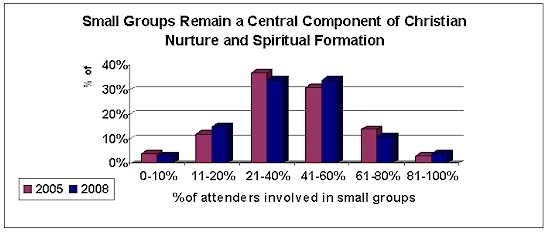
• No longer close-knit. Likewise, there has been a significant decline in the number of megachurches who somewhat or strongly agree that the phrase “like a close-knit family” describes them, falling from 72% in 2005 to 62% in 2008. Given these findings, perhaps the renewed emphasis on small groups by over a third of megachurches is in reaction to a perceived social disconnectedness more than a proactive strategy.
• Social justice and community service. An area where significant proactive change clearly seems to be taking place among megachurches is within social ministry and community service programming and involvement. In 2000 a third (34%) of megachurches affirmed their congregation was “working for social justice.” By 2005, nearly a half (49%) of congregations somewhat or strongly agreed this phrase described them well and in 2008 51% of churches affirmed this.
In the 2008 study, nearly three-quarters (73%) of the megachurches stated that community service activities were given a lot of programmatic emphasis in the past year or were a specialty of the church. Fifty-eight percent of churches say they invite new members to volunteer for service in the community. Additionally 90% of the megachurches surveyed agree that the phrase “We are a positive force for good in our community” describes them quite or very well. It is important to note, however, that the focus on social ministry, community outreach and social justice are emphases increasingly shared by over half of megachurches.
Such a change shouldn’t be too surprising given the attention megachurch pastors like Saddleback's Rick Warren (www.saddleback.com) have received for his work on AIDS or other churches have received surrounding Hurricane Katrina relief or in response to other natural disasters. |
• Generic evangelicalism. Another aspect of megachurch life that greatly affects the worship, style and orientation of these congregations is the perceived theological identity of the majority of the attenders. This labeling of the attenders theological perspective has drastically shifted in 8 years. The vast majority of megachurches have always held a conservative theological position, and this hasn’t changed. But what has changed is a turn away from distinctive theological segments within conservative Protestantism toward a “generic evangelicalism.” During the past 8 years, nearly 20% more churches chose to describe the theological orientation of the congregation as “evangelical” rather than one of the distinctive variations within conservativism. In some sense the term “evangelical” can be seen as generically encompassing an increasingly broad spectrum of conservative Christians as the subgroup distinctions, such as Pentecostal, traditional, charismatic, etc., are less important or significant.
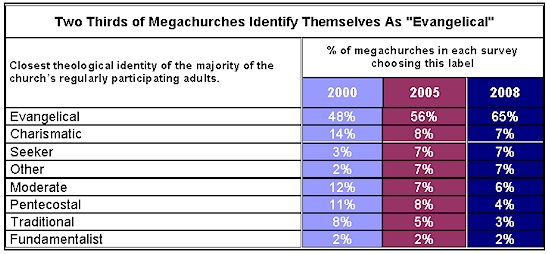
• Politically moderating. A similar shift to a more moderated position can be seen in the label that 2008 respondents chose to describe the majority of the congregation’s political stance. This moderated political position may come as a surprise given the large amount of news reports that describe megachurches as right wing bastions of republicanism. While it is indeed true that the majority of megachurch attenders are republicans, this data shows that they are not the arch-conservatives many people portray them as.

Neither are megachurches overtly political. The 2008 survey asked a series of 7 questions to determine the political activities that took place at these churches over the past year. None of the questions garnered more than 30% of the churches stating they were involved in these activities, and the majority of questions received the support of 10% or less of the churches. These findings confirm the earlier 2005 study results that showed only 16% of megachurches had partnered with other churches in political activities over the previous 5 years and only 24% had ever done so. Contrary to the stereotype about these congregations, based on a few high-profile political activist megachurch pastors such as Rod Parsley of the Columbus, Ohio, megachurch World Harvest Church who in the 2004 election claimed to have won the state for the Republicans, megachurches are generally not politically involved. They, like most congregations in the country, prefer to keep politics and religion separate.
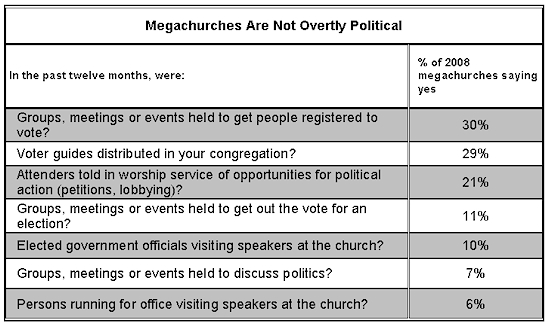
Model Making
Like all expressions of a growing vital life of faith, megachurches continue to evolve and adapt in response to an ever-changing social and religious context. We live in a time of rapid social change; therefore, it is not surprising that the most innovative of religious congregations in our country would show significant movement even within 8 years of time. The alterations that take place in megachurches are the large print versions of the texts all congregations will explore in some way. Whether consciously or not, a surprising number of American churches follow the development, changes and adaptations of their megachurch counterparts. While some seek to mimic these congregations, and some become highly vocal critics of them, many more learn from their efforts and examples, adapting different practices to their own individual contexts.
Next in This Series
Further reports and topic-specific analyses of the 2008 megachurches study will follow this publication. The series is named American Megachurch Updates and each installment will be co-released at the websites of the Hartford Institute for Religion Research www.hartfordinstitute.org and Leadership Network www.leadnet.org.
Project Directors and Authors:
Scott Thumma (PhD, Emory University) is a researcher in the Hartford Institute for Religion Research and Professor of Sociology of Religion at Hartford Seminary. His latest book, Beyond Megachurch Myths (2007) debunks many of the false assumptions about megachurches. Contact Scott at sthumma@hartsem.edu
Warren Bird (PhD, Fordham University) serves as a primary researcher and writer for Leadership Network and has more than ten years of church staff and seminary teaching experience. He has collaboratively written 20 books, all on subjects of church health or church innovation. Contact Warren at warren.bird@leadnet.org
About the study: The 2008 research study was jointly conducted by Hartford Institute for Religion Research at Hartford Seminary (www.hartfordinstitute.org) and Leadership Network, Dallas, Texas (www.leadnet.org). Surveys were distributed and received between February and August, 2008.
Scott Thumma and Warren Bird were the principal researchers behind the study, with support from Leadership Network staff Dave Travis, Stephanie Plagens, Bonnie Randle, Cynthia Beal, Carolyn White, Julia Burk, Zanetta Tavares, DJ Chuang, Todd Rhoades, Cindi Haworth, and Yolanda Cardenas. This large team focused on obtaining accurate staff contact information, both email and postal mail, for all known U.S. Protestant megachurches. As such the 2008 survey contacted a roughly equal number of megachurches as did the 2005 survey.
The 2008 questionnaire was sent to 1,659 churches thought to have attendances of 1,600 and higher, but only those responses from churches with more than 1,800 in combined weekend attendance were used for the analysis. The resulting usable questionnaires included 397 (1,800 and up) 372 (2,000 and up) usable questionnaires for a 31% response rate. Unless specified otherwise, the numbers listed in the results are valid percentages. That is, they are the percent of respondents to that particular item, not the percent of total number of respondents.
These surveys were weighted by region and size (attendance) categories, based on the characteristics of the listing of megachurches in the U.S. maintained jointly by the two organizations, so as to correct, as much as possible, for sample variations. The error attributable to sampling at the 95% level of confidence is 3%+/-.
This is not a longitudinal panel study of exactly the same churches. We have attempted to correct for any anomaly in the samples, especially for the 2000 data as it was based on a smaller sample of 153 usable responses.
For information on the methodology used in the 2005 survey, see http://hirr.hartsem.edu/megachurch/megastoday2005summaryreport.pdf.
and http://hirr.hartsem.edu/megachurch/megastoday2005_method.html
For information on the methodology used in the 2000 survey, see http://hirr.hartsem.edu/megachurch/faith_megachurches_FACTsummary.html and http://fact.hartsem.edu/denom/Megas-FactFreq.pdf
This report was released on September 12, 2008. Copyright 2008 by Leadership Network and Hartford Seminary, Hartford Institute for Religion Research
If you have questions, please direct them to:
Scott Thumma
Hartford Institute for Religion Research
Hartford Seminary
77 Sherman St.
Hartford, CT 06105
sthumma@hartsem.edu
|
Warren Bird
Leadership Network
2626 Cole Ave., Suite 900
Dallas, Texas 75204
Warren.Bird@leadnet.org
|
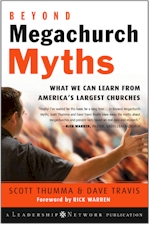
If you are interested in megachurches, you might find this 2007 book co-authored by Hartford Institute professor, Scott Thumma, interesting.
|
